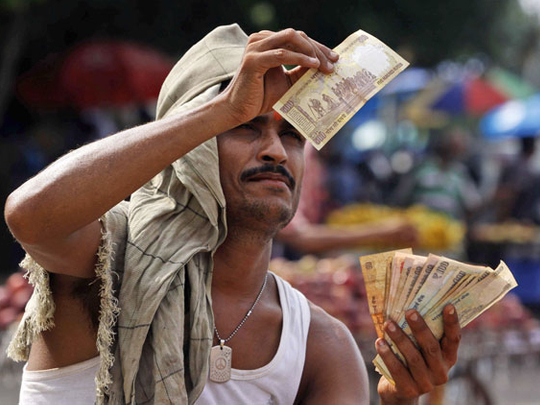
Mumbai: The US Federal Reserve’s decision to press ahead with its asset-buying gives India’s battered rupee a reprieve and creates space at a policy review on Friday for its central bank to scale back some of the measures put in place to support the currency.
But the same release of pressure on the currency could also send a signal that the worst of India’s crisis is over, which risks fuelling complacency among policymakers - already gearing up for national elections by May - about the need for tough reforms to make the economy more investor friendly.
At the Finance Ministry in New Delhi, some officials who had stayed up late to watch the Fed decision on TV expressed relief.
Worries earlier this year that the Fed would reduce its stimulus had triggered an exodus from emerging markets and exposed an Indian economy saddled with hefty current account and fiscal deficits and a government with little political will to push through difficult economic reforms. As investors rushed for the exit, the rupee tumbled to a record low in August for a loss of around 20 percent this year.
The currency has since risen 11.4 percent, helped by a raft of emergency measures put in place by Indian authorities, including the Reserve Bank of India (RBI), the central bank.
It rallied 2.6 percent on Thursday after the Fed’s unexpected move to maintain its cash injections into the world’s biggest economy at $85 billion a month.
“There is certainly the danger of a more relaxed stance from the policymakers till the next round of tapering concerns hit the markets. They should just see this as a 2-3 months reprieve,” said Robert Prior-Wandesforde, economist at Credit Suisse in Singapore.
“The RBI should not use this to ease monetary conditions.
The rupee has only retraced a month’s losses and is certainly not strong or stable. My sense is RBI will not touch the key rates but the tone will be somewhat more dovish,” Prior-Wandesforde said.
The principal economic adviser at the Ministry of Finance, Dipak Dasgupta, said the Fed decision “was a huge surprise” and a “very positive decision.” He said it could add half a percentage point to India’s economic growth in the near term.
“We have the opportunity to step up growth to 6.5 percent by March 2014,” he said. June quarter growth hit 4.4 percent, the weakest in four years.
“This gives us a chance to rethink ways to jumpstart growth on a sustainable basis,” he said.
SICKLY STATE However, India’s underlying economic imbalances remain and the weak coalition government of Prime Minister Manmohan Singh has shown limited ability to push through reforms that might correct them, such as easing limits on foreign investment in insurance and implementing a goods and service tax.
Recent reforms, such as liberalising foreign investment in industries such as telecoms and energy, are viewed as positive but not a substitute for major overhauls of tax and labour laws economists say hold back India’s potential.
“I am worried that this will send the wrong signal to Indian policymakers about the need for further reform and prudent macro-economic policy,” said a foreign hedge fund manager who follows India closely and declined to be identified.
India’s economic growth has slumped from a double digit pace seen in early 2010, inflation is rising, companies are struggling, and bank asset quality is worsening. The current account deficit is at a record high and the country’s credit rating is one precarious notch above junk status.
While Finance Minister P. Chidambaram has vowed to meet his target of trimming the fiscal deficit to 4.8 percent of GDP this fiscal year, that leaves little room for investment to spur growth. Instead, the signature legislative achievement in the most recent session of parliament was a costly food programme.
Meanwhile, Fed Chairman Ben Bernanke’s decision not to scale-back bond-buying triggered a jump in the prices of oil and gold, India’s two biggest imports.
That means the current account deficit could come under renewed pressure, while higher fuel prices will add to inflation and the subsidy bill, weighing on India’s fiscal deficit.
“Policymakers may be lulled into a sense of complacency and slow the reform momentum,” Nomura economist Sonal Varma, who expects the Indian economy to grow at just 4.2 percent this year, wrote following the Fed’s move.
NOT NOW DOESN’T MEAN NEVER New central bank chief Raghuram Rajan presents his first monetary policy statement on Friday.
With the benefit of the Fed meeting’s outcome - Rajan deferred his own policy review by two days - he might be more inclined to begin scaling back some of the steps that have supported the rupee but stifled credit.
However, a Reuters poll before the Fed decisions showed most economists expect the RBI to leave unchanged the 10.25 percent marginal standing facility, an overnight rate widely seen as the central bank’s main interest rate tool to support the rupee.
Some economists said it was more likely the RBI might roll-back some of the other temporary rupee support measures, such as a rule that banks meet 99 percent of their cash reserve ratio requirement on a daily basis. The minimum was increased from 70 percent previously. Relaxing the rules could provide more cash for credit.
Some RBI-watchers said the Fed’s decision would have more influence on language than action.
“RBI’s tone will be more dovish now than its pre-Fed stance.
However, because the issues around inflation and vulnerability to an oil rally remain, I don’t see the unwinding of the recent measures coming now,” said Anindya Dasgupta, managing director for global markets at Barclays in Mumbai.
One senior finance ministry official in New Delhi said the Fed’s decision comes as a relief but noted that it will begin tapering eventually. Hopefully, the official said, India’s economy is in better shape when that happens.
“The lesson is carry on with reforms, improve growth and strengthen the economy,” the official said.












